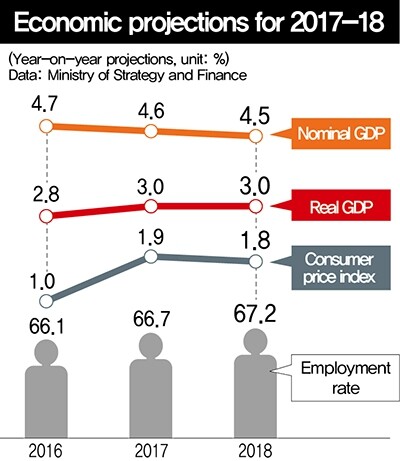hankyoreh
Links to other country sites 다른 나라 사이트 링크
Could South Korea’s economic growth rate top 3% for first time since 2014?

The Moon Jae-in administration projected an economic growth rate of 3% for its first year in office. The figure takes into account the recovery in the global economy and the effects of a supplementary budget for jobs. To achieve income-driven growth, the administration plans to manage the rate of increase in fiscal expenditures to keep it above the current growth rate at 5% or more.
The Ministry of Strategy and Finance predicted a 2017 growth rate of 3% with the release of its “new administration economic policy direction” on July 25. If the projection comes to pass, it will be the first time the South Korean economy has experienced growth rate at or above 3% since 2014 (3.3%). In late 2016, the South Korean government predicted a 2017 growth rate of 2.6%.
The basis for the 3% prediction appears to be a recovery in exports and investment due to strong global economic conditions. Exports recorded consecutive double digit growth over a six-month period starting in January, chiefly through mainstay items such as semiconductors and petrochemicals. Facility investment is also on the rise amid increased investment in machinery, including major manufacturing equipment.
“The business recovery is likely to last into the second half of the year, but the growth momentum does appear poised to drop off somewhat compared to the first half,” said Deputy Finance Minister Lee Chan-woo.
“The policy effects may have weakened with the delay in passing the revised supplementary budget, but we’re currently predicting something in the range of 0.2 percentage points,” Lee said of the effects in increasing the growth rate. The administration also projected a 3% growth rate for the economy in 2018.
The administration also emphasized the role of fiscal spending in increasing household income and creating jobs. It currently plans to manage the rate of increase in fiscal expenditures over the next five years to keep it higher than the current growth rate, taking inflation into account. The administration‘s current growth rate forecast for 2017 is 4.6%. This suggests it plans to pursue a more expansionary fiscal policy approach than announced in its 2016-2010 national fiscal management plan last year, which reined in the rate of increase in fiscal expenditures to an annual average of 3.5% over the next five years.
“According to a governance policy advisory committee report, the increase in total expenditures is currently predicted at around 4.7%,” said Deputy Prime Minister and Minister of Strategy and Finance Kim Dong-yeon in a July 25 briefing on the economic policy direction.
“If the current growth rate is expected to be around 4.9-5%, the administration will manage the rate of increase in total expenditures to keep it higher than that throughout its term,” Kim said.
But the plan is also a step back from the 7% average annual rate of increase in fiscal spending that President Moon Jae-in announced with his “J-nomics” vision during the presidential election campaign. The aim appears to be to leave some room for fiscal spending within the upper 4% to 7% range, given the fluid tax revenue situation and the political sensitivity of attempting a tax increase. The administration also plans to increase the percentage of social service spending out of gross domestic product (10.4% in 2016) to an appropriate level reflecting South Korea’s aging society trend.
“If you look at other countries, it looks as though it should be increased by around two to three percentage points from its current level [during Moon‘s five-year term],” Lee Chan-woo said.
By Noh Hyun-woong, staff reporter
Please direct questions or comments to [english@hani.co.kr]

Editorial・opinion
![[Column] Season 2 of special prosecutor probe may be coming to Korea soon [Column] Season 2 of special prosecutor probe may be coming to Korea soon](https://flexible.img.hani.co.kr/flexible/normal/500/300/imgdb/original/2024/0426/3317141030699447.jpg) [Column] Season 2 of special prosecutor probe may be coming to Korea soon
[Column] Season 2 of special prosecutor probe may be coming to Korea soon![[Column] Park Geun-hye déjà vu in Yoon Suk-yeol [Column] Park Geun-hye déjà vu in Yoon Suk-yeol](https://flexible.img.hani.co.kr/flexible/normal/500/300/imgdb/original/2024/0424/651713945113788.jpg) [Column] Park Geun-hye déjà vu in Yoon Suk-yeol
[Column] Park Geun-hye déjà vu in Yoon Suk-yeol- [Editorial] New weight of N. Korea’s nuclear threats makes dialogue all the more urgent
- [Guest essay] The real reason Korea’s new right wants to dub Rhee a founding father
- [Column] ‘Choson’: Is it time we start referring to N. Korea in its own terms?
- [Editorial] Japan’s rewriting of history with Korea has gone too far
- [Column] The president’s questionable capacity for dialogue
- [Column] Are chaebol firms just pizza pies for families to divvy up as they please?
- [Column] Has Korea, too, crossed the Rubicon on China?
- [Correspondent’s column] In Japan’s alliance with US, echoes of its past alliances with UK
Most viewed articles
- 1No good, very bad game for Korea puts it out of Olympics for first time since 1988
- 2Division commander ordered troops to enter raging flood waters before Marine died, survivor says
- 3Korea’s 1.3% growth in Q1 signals ‘textbook’ return to growth, says government
- 4Will NewJeans end up collateral damage in internal feud at K-pop juggernaut Hybe?
- 5[Column] Season 2 of special prosecutor probe may be coming to Korea soon
- 6[Editorial] Korea’s surprise Q1 growth requires objective assessment, not blind fanfare
- 7[Column] ‘Choson’: Is it time we start referring to N. Korea in its own terms?
- 8‘We must say no’: Seoul defense chief on Korean, USFK involvement in hypothetical Taiwan crisis
- 9Korea sees more deaths than births for 52nd consecutive month in February
- 10Is N. Korea threatening to test nukes in response to possible new US-led sanctions body?